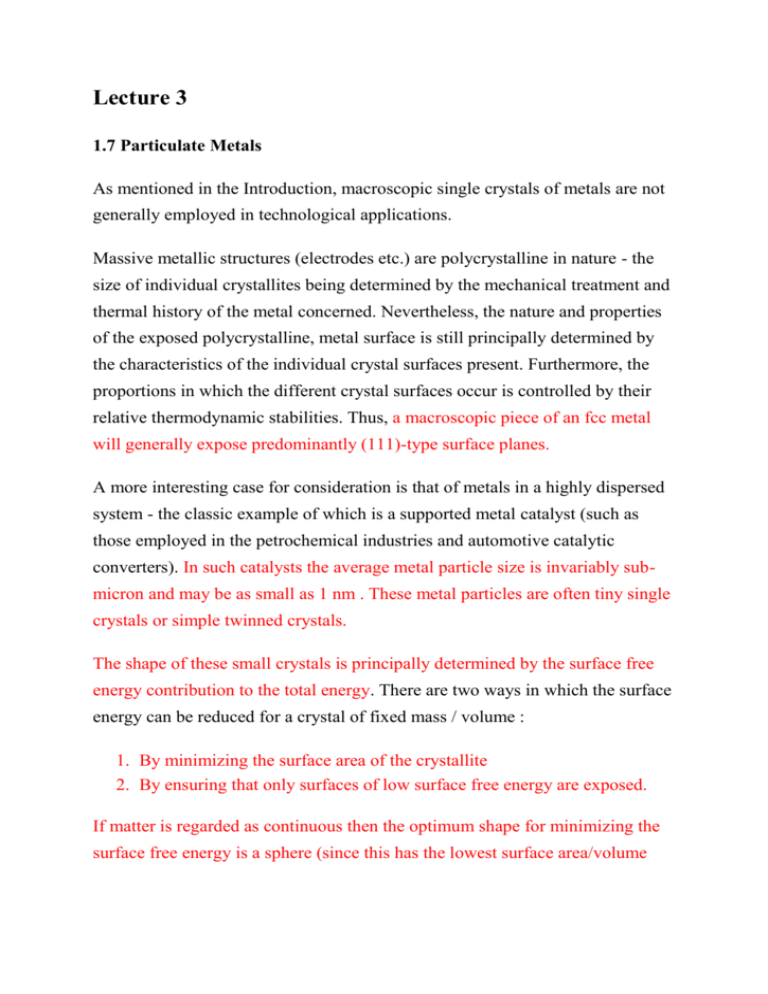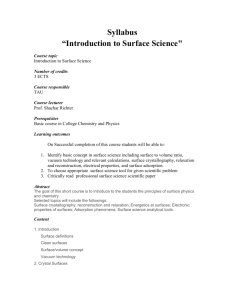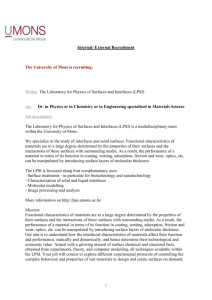pubdoc_10_3193_250
advertisement

Lecture 3
1.7 Particulate Metals
As mentioned in the Introduction, macroscopic single crystals of metals are not
generally employed in technological applications.
Massive metallic structures (electrodes etc.) are polycrystalline in nature - the
size of individual crystallites being determined by the mechanical treatment and
thermal history of the metal concerned. Nevertheless, the nature and properties
of the exposed polycrystalline, metal surface is still principally determined by
the characteristics of the individual crystal surfaces present. Furthermore, the
proportions in which the different crystal surfaces occur is controlled by their
relative thermodynamic stabilities. Thus, a macroscopic piece of an fcc metal
will generally expose predominantly (111)-type surface planes.
A more interesting case for consideration is that of metals in a highly dispersed
system - the classic example of which is a supported metal catalyst (such as
those employed in the petrochemical industries and automotive catalytic
converters). In such catalysts the average metal particle size is invariably submicron and may be as small as 1 nm . These metal particles are often tiny single
crystals or simple twinned crystals.
The shape of these small crystals is principally determined by the surface free
energy contribution to the total energy. There are two ways in which the surface
energy can be reduced for a crystal of fixed mass / volume :
1. By minimizing the surface area of the crystallite
2. By ensuring that only surfaces of low surface free energy are exposed.
If matter is regarded as continuous then the optimum shape for minimizing the
surface free energy is a sphere (since this has the lowest surface area/volume
ratio of any 3D object) - this is why liquid droplets in free space are basically
spherical.
Unfortunately, we cannot ignore the discrete, atomic nature of matter and the
detailed atomic structure of surfaces when considering particles of the size
found in catalysts. If, for example, we consider an fcc metal (eg. Pt) and ensure
that only the most stable (111)-type surfaces are exposed, then we end up with a
crystal which is an octahedron.
Octahedron exposing
8 symmetry-related
fcc(111)-type faces
( Note : there are 8 different, but crystallographically-equivalent, surface planes
which have the (111) surface structure - the {111} faces. They are related by the
symmetry elements of the cubic fcc system).
A compromise between exposing only the lowest energy surface planes and
minimizing the surface area is obtained by truncating the vertices of the
octahedron - this generates a cubo-octahedral particle as shown below, with 8
(111)-type surfaces and 6 smaller, (100)-type surfaces and gives a lower
(surface area / volume) ratio.
Crystals of this general form are often used as conceptual models for the metal
particles in supported catalysts.
The atoms in the middle of the {111} faces show the expected CN=9
characteristic of the (111) surface. Similarly, those atoms in the centre of the
{100} surfaces have the characteristic CN=8 of the (100) surface.
However, there are also many atoms at the corners and intersection of surface
planes on the particle which show lower coordination numbers.
What is the lowest coordination number exhibited by a surface atom on
this crystallite ?
This model for the structure of catalytic metal crystallites is not always
appropriate : it is only reasonable to use it when there is a relatively weak
interaction between the metal and the support phase (e.g. many silica supported
catalysts).
A stronger metal-support interaction is likely to lead to increased "wetting" of
the support by the metal, giving rise to :
a greater metal-support contact area
a significantly different metal particle morphology
For example
In the case of a strong metal-support interaction the metal/oxide interfacial free
energy is low and it is inappropriate to consider the surface free energy of the
metal crystallite in isolation from that of the support.
Our knowledge of the structure of very small particles comes largely from high
resolution electron microscopy (HREM) studies - with the best modern
microscopes it is possible to directly observe such particles and resolve atomic
structure.
1.8 Other Single Crystal Surfaces
Although some of the more common metallic surface structures have been
discussed in previous sections (1.2-1.4), there are many other types of single
crystal surface which may be prepared and studied. These include
high index surfaces of metals
single crystal surfaces of compounds
These will not be covered in any depth, but a few illustrative examples are
given below to give you a flavour of the additional complexity involved when
considering such surfaces.
High Index Surfaces of Metals
High index surfaces are those for which one or more of the Miller Indices are
relatively large numbers. The most commonly studied surfaces of this type are
vicinal surfaces which are cut at a relatively small angle to one of the low index
surfaces. The ideal surfaces can then be considered to consist of terraces which
have an atomic arrangement identical with the corresponding low index surface,
separated by monatomic steps (steps which are a single atom high).
Perspective view of the
fcc(775) surface
As seen above, the ideal fcc(775) surface has a regular array of such steps and
these steps are both straight and parallel to one another.
What is the coordination number of a step atom on this surface ?
By contrast a surface for which all the Miller indices differ must not only
exhibit steps but must also contain kinks in the steps. An example of such a
surface is the fcc(10.8.7) surface - the ideal geometry of which is shown below.
Perspective view of the
fcc(10.8.7) surface
What is the lowest coordination number exhibited by any of the atoms on
this surface ?
Real vicinal surfaces do not, of course, exhibit the completely regular array of
steps and kinks illustrated for the ideal surface structures, but they do exhibit
this type of step and terrace morphology. The special adsorption sites available
adjacent to the steps are widely recognised to have markedly different
characteristics to those available on the terraces and may thus have an important
role in certain types of catalytic reaction.
For further information on the structure of metal surfaces you should take a look
at :
Metal Surfaces.
An Atlas of Models of Crystal Surfaces , by J.F.
Nicholas (Gordon & Breach, 1965)
Surfaces of fcc, bcc, and hcp metals and The Surface Explorer (based at the Fritz Haber
the diamond and graphite structures.
Institute) - an on-line interactive surface structure
utility.
Single Crystal Surfaces of Compounds
The ideal surface structures of the low index planes of compound materials can
be easily deduced from the bulk structures in exactly the same way as can be
done for the basic metal structures. For example, the NaCl(100) surface that
would be expected from the bulk structure is shown below :
Perspective view of the
NaCl(100) surface
In addition to the relaxation and reconstruction exhibited by elemental surfaces,
the surfaces of compounds may also show deviations from the bulk
stoichiometry due to surface localised reactions (e.g. surface reduction) and/or
surface segregation of one or more components of the material.
2. Adsorption of Molecules on Surfaces
SUB-MENU
2.1 Introduction to Molecular Adsorption
2.2 How do Molecules Bond to Surfaces ?
2.3 Kinetics of Adsorption
2.4 PE Curves & Energetics of Adsorption
2.5 Adsorbate Geometries & Structures
2.6 The Desorption Process
2.1 Introduction to Molecular Adsorption
The adsorption of molecules on to a surface is a necessary prerequisite to any
surface mediated chemical process.
For example, in the case of a surface catalysed reaction it is possible to break
down the whole continuously-cycling process into the following five basic steps
:
1.
2.
3.
4.
5.
Diffusion of reactants to the active surface
Adsorption of one or more reactants onto the surface
Surface reaction
Desorption of products from the surface
Diffusion of products away from the surface
The above scheme not only emphasises the importance of the adsorption
process but also its reverse - namely desorption. It is these two processes which
are considered in this Section.
Notes on Terminology :
Substrate - frequently used to describe the solid surface onto which adsorption
can occur; the substrate is also occasionally (although not here) referred to as
the adsorbent.
Adsorbate - the general term for the atomic or molecular species which are
adsorbed (or are capable of being adsorbed) onto the substrate.
Adsorption - the process in which a molecule becomes adsorbed onto a surface
of another phase (note - to be distinguished from absorption which is used when
describing uptake into the bulk of a solid or liquid phase)
Coverage - a measure of the extent of adsorption of a species onto a surface
(unfortunately this is defined in more than one way !). It is usually denoted by
the lower case Greek "theta", θ
Exposure - a measure of the amount of gas which a surface has seen; more
specifically, it is the product of the pressure and time of exposure (normal unit
is the Langmuir, where 1 L = 10-6 Torr s ).
2.2 How do Molecules Bond to Surfaces ?
There are two principal modes of adsorption of molecules on surfaces :
Physical Adsorption ( Physisorption )
Chemical Adsorption ( Chemisorption )
The basis of distinction is the nature of the bonding between the molecule and
the surface. With ...
Physical Adsorption : the only bonding is by weak Van der Waals - type forces.
There is no significant redistribution of electron density in either the molecule
or at the substrate surface.
Chemisorption : a chemical bond, involving substantial rearrangement of
electron density, is formed between the adsorbate and substrate. The nature of
this bond may lie anywhere between the extremes of virtually complete ionic or
complete covalent character.
Typical Characteristics of Adsorption Processes
Material Specificity
(variation between
substrates of different
chemical composition)
Chemisorption
Physisorption
Substantial variation
between materials
Slight dependence upon
substrate composition
Crystallographic
Marked variation
Specificity
between crystal planes
(variation between
different surface planes of
the same crystal)
Virtually independent of
surface atomic geometry
Temperature Range
(over which adsorption
occurs)
Virtually unlimited
(but a given molecule
may effectively adsorb
only over a small range)
Near or below the
condensation point of the
gas
(e.g. Xe < 100 K, CO2 <
200 K)
Adsorption Enthalpy
Wide range (related to the
chemical bond strength)
- typically 40 - 800 kJ
mol-1
Related to factors like
molecular mass and
polarity
- typically 5-40 kJ mol-1
(similar to heat of
liquefaction)
Nature of Adsorption
Often dissociative
May be irreversible
Non-dissociative
Reversible
Saturation Uptake
Limited to one monolayer Multilayer uptake
possible
Kinetics of Adsorption
Very variable - often an
activated process
Fast - since it is a nonactivated process
The most definitive method for establishing the formation of a chemical bond
between the adsorbing molecule and the substrate ( i.e. chemisorption ) is to use
an appropriate spectroscopic technique, for example
IR ( see Section 5.4 ) - to observe the vibrational frequency of the
substrate/adsorbate bond
UPS ( see Section 5.3 ) - to monitor intensity & energy shifts in the valence
orbitals of the adsorbate and substrate








